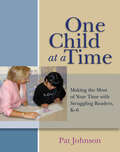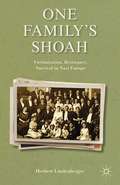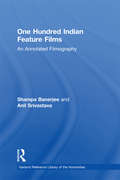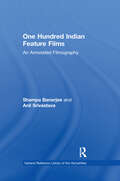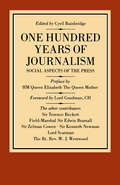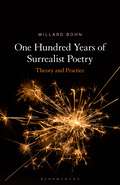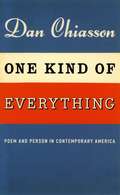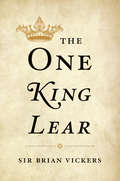- Table View
- List View
One Book/Five Ways: The Publishing Procedures of Five University Presses
by Association of Association of American University Presses Joyce KachergisA testament to the ingenuity of scholarly presses, One Book/Five Ways is a fascinating experiment in comparative publishing. This book records the history of a single manuscript, entitled No Time for Houseplants, submitted to five different university presses—Chicago, MIT, North Carolina, Texas, and Toronto—and then actually published by the University of Oklahoma Press. Each of the five model publishers agreed to treat the book as a real project accepted for publication and to compile a log of procedures they followed. These logs include correspondence, budgets, forms, layouts, and specifications, providing an insider's look at the path a manuscript takes through the various departments of each press, from editorial to marketing. With a new Foreword discussing changes in publishing since 1978 and an Afterword commenting on the actual publication of No Time for Houseplants, One Book/Five Ways is a unique educational tool for anyone interested in the publishing process.
One Child at a Time: Making the Most of Your Time with Struggling Readers, K-6
by Pat JohnsonEvery elementary teacher deals with students who struggle as readers on a daily basis. Each struggling child is complex and each has a unique history as a learner. In One Child at a Time, experienced literacy specialist and consultant Pat Johnson provides a framework she has used in numerous K-6 classrooms to help teachers understand and assist individual children. The four-step process outlined in the book enables teachers to focus carefully on specific strategies and behaviors; analyze them with theoretical and practical lenses; design targeted instruction in keeping with current research on reading process; and then assess and refine the teaching in conferences with the child. The framework is by no means an easy answer to a difficult problem, but through its use teachers learn how the reading process works for proficient readers and how to support struggling readers as they construct their own reading process. The text is packed with examples of actual conferences with students, detailing how and when Pat and her colleagues intervene to instruct and assess. The examples of follow-up assessment and analysis of struggling readers over days and weeks provide an indispensable model for teachers. Pat shows how to use this framework successfully with a range of learners, including young children, English language learners, and students in the upper elementary grades who are stalled in their literacy progress. She builds upon her decades of work as a classroom teacher, literacy specialist, and consultant in schools with high poverty and diversity, to demonstrate how this framework can be useful in any setting.
One Child at a Time: Making the Most of Your Time with Struggling Readers, K-6
by Pat JohnsonEvery elementary teacher deals with students who struggle as readers on a daily basis. Each struggling child is complex and each has a unique history as a learner. In One Child at a Time, experienced literacy specialist and consultant Pat Johnson provides a framework she has used in numerous K-6 classrooms to help teachers understand and assist individual children. The four-step process outlined in the book enables teachers to focus carefully on specific strategies and behaviors; analyze them with theoretical and practical lenses; design targeted instruction in keeping with current research on reading process; and then assess and refine the teaching in conferences with the child. The framework is by no means an easy answer to a difficult problem, but through its use teachers learn how the reading process works for proficient readers and how to support struggling readers as they construct their own reading process. The text is packed with examples of actual conferences with students, detailing how and when Pat and her colleagues intervene to instruct and assess. The examples of follow-up assessment and analysis of struggling readers over days and weeks provide an indispensable model for teachers. Pat shows how to use this framework successfully with a range of learners, including young children, English language learners, and students in the upper elementary grades who are stalled in their literacy progress. She builds upon her decades of work as a classroom teacher, literacy specialist, and consultant in schools with high poverty and diversity, to demonstrate how this framework can be useful in any setting.
One Day in the Life of the English Language: A Microcosmic Usage Handbook
by Frank L. CioffiGenerations of student writers have been subjected to usage handbooks that proclaim, "This is the correct form. Learn it"—books that lay out a grammar, but don't inspire students to use it. By contrast, this antihandbook handbook, presenting some three hundred sentences drawn from the printed works of a single, typical day in the life of the language—December 29, 2008—tries to persuade readers that good grammar and usage matter.Using real-world sentences rather than invented ones, One Day in the Life of the English Language gives students the motivation to apply grammatical principles correctly and efficiently. Frank Cioffi argues that proper form undergirds effective communication and ultimately even makes society work more smoothly, while nonstandard English often marginalizes or stigmatizes a writer. He emphasizes the evolving nature of English usage and debunks some cherished but flawed grammar precepts. Is it acceptable to end a sentence with a preposition? It is. Can you start a sentence with a conjunction? You can. OK to split an infinitive? No problem.A grammar and usage handbook like no other, One Day in the Life of the English Language features accessible chapters divided into "Fundamentals," "Fine Tuning," and "Deep Focus," allowing readers to select a level most suited to their needs. It also includes a glossary, a teachers' guide, and a section refuting some myths about digital-age English.
One Day in the Life of the English Language: A Microcosmic Usage Handbook
by Frank L. CioffiGenerations of student writers have been subjected to usage handbooks that proclaim, "This is the correct form. Learn it"—books that lay out a grammar, but don't inspire students to use it. By contrast, this antihandbook handbook, presenting some three hundred sentences drawn from the printed works of a single, typical day in the life of the language—December 29, 2008—tries to persuade readers that good grammar and usage matter.Using real-world sentences rather than invented ones, One Day in the Life of the English Language gives students the motivation to apply grammatical principles correctly and efficiently. Frank Cioffi argues that proper form undergirds effective communication and ultimately even makes society work more smoothly, while nonstandard English often marginalizes or stigmatizes a writer. He emphasizes the evolving nature of English usage and debunks some cherished but flawed grammar precepts. Is it acceptable to end a sentence with a preposition? It is. Can you start a sentence with a conjunction? You can. OK to split an infinitive? No problem.A grammar and usage handbook like no other, One Day in the Life of the English Language features accessible chapters divided into "Fundamentals," "Fine Tuning," and "Deep Focus," allowing readers to select a level most suited to their needs. It also includes a glossary, a teachers' guide, and a section refuting some myths about digital-age English.
One Day in Wonderland: A Celebration of Lewis Carroll's Alice
by Kathleen KrullA joyful, playful celebration of Lewis Carroll's love of language combined with an introduction to his life and the origin of Alice's Adventures in Wonderland, exquisitely illustrated by Júlia Sardà.The wordsmith Lewis Carroll is famed for the freewheeling world of Wonderland in his beloved classics Alice’s Adventures in Wonderland and Through the Looking Glass. In this gloriously illustrated book, Carroll's childlike love of life is showcased alongside his brilliance at creating and adapting playful words and phrases. From brillig and uglification to frumious and chortle, the award-winning author Kathleen Krull uses many of Carroll’s own words to tell the story of a man who wanted to make children laugh and whose legacy continues to entertain and delight. There is a glossary of Carroll's invented words at the back of the book.Júlia Sardà's striking illustrations offer an interpretation of Lewis Carroll's work that is faithful to the spirit of his writing and the look of the real life Alice. Packed with rich and surprising details, Júlia's artwork makes this a stunning book to treasure. Fans will enjoy the complete and unabridged edition of Alice's Adventures of Wonderland with gorgeous colour illustrations by Júlia Sardà throughout, also published by Two Hoots.One Day in Wonderland is the perfect gift for all fans of Alice, young and old.
One Day When We Were Young
by Nick PayneI am scared, that once this war is over, and I am sent home, that you won't be here. That you will have left. Leonard and Violet, young, restless and in love, spend their first night together knowing it may also be their last. It's 1942 and, in a hotel room in Bath, they dream of their future while preparing for Leonard's departure to the war. But the bombs begin to fall and their world will never be the same again.In the year 2002, the couple look back at what might have been.Examining the impact of the Second World War on two ordinary lives and a love that spans more than sixty years, Nick Payne's One Day When We Were Young premiered at the Crucible Studio, Sheffield, in October 2011 in a Paines Plough production.
One Family’s Shoah: Victimization, Resistance, Survival in Nazi Europe (Studies in European Culture and History)
by H. LindenbergerDeploying concepts of interpretation, liberation, and survival, esteemed literary critic Herbert Lindenberger reflects on the diverse fates of his family during the Holocaust. Combining public, family, and personal record with literary, musical, and art criticism, One Family's Shoah suggests a new way of writing cultural history.
One Green Bottle (Oberon Modern Plays)
by Hideki Noda Will SharpeBoo, Bo and Pickle have all made plans tonight. But someone has to stay home and look after Princess. People are waiting, start times are looming. No one’s budging and petty bickering soon spirals into a ludicrous battle of wills and, possibly, the end of the world. Renowned Japanese writer, performer and Artistic Director of the Tokyo Metropolitan Theatre Hideki Noda paints a portrait of a disconnected family on a self-destructive course in this satirical comedy about consumerism and technology in a ‘selfie’ society.
One Hundred Indian Feature Films: An Annotated Filmography
by Srivastava BanerjeeFirst Published in 1989. Routledge is an imprint of Taylor & Francis, an informa company.
One Hundred Indian Feature Films: An Annotated Filmography
by Srivastava BanerjeeFirst Published in 1989. Routledge is an imprint of Taylor & Francis, an informa company.
One Hundred Years of Surrealist Poetry: Theory and Practice
by Willard BohnGiven that the Surrealists were initially met with widespread incomprehension, mercilessly ridiculed, and treated as madmen, it is remarkable that more than one hundred years on we still feel the vitality and continued popularity of the movement today. As Willard Bohn demonstrates, Surrealism was not just a French phenomenon but one that eventually encompassed much of the world. Concentrating on the movement's theory and practice, this extraordinarily broad-ranging book documents the spread of Surrealism throughout the western hemisphere and examines keys texts, critical responses, and significant writers. The latter include three extraordinarily talented individuals who were eventually awarded the Nobel Prize in Literature (Andre Breton, Pablo Neruda, and Octavio Paz). Like their Surrealist colleagues, they strove to free human beings from their unconscious chains so that they could realize their true potential. One Hundred Years of Surrealist Poetry explores not only the birth but also the ongoing life of a major literary movement.
One Hundred Years of Surrealist Poetry: Theory and Practice
by Willard BohnGiven that the Surrealists were initially met with widespread incomprehension, mercilessly ridiculed, and treated as madmen, it is remarkable that more than one hundred years on we still feel the vitality and continued popularity of the movement today. As Willard Bohn demonstrates, Surrealism was not just a French phenomenon but one that eventually encompassed much of the world. Concentrating on the movement's theory and practice, this extraordinarily broad-ranging book documents the spread of Surrealism throughout the western hemisphere and examines keys texts, critical responses, and significant writers. The latter include three extraordinarily talented individuals who were eventually awarded the Nobel Prize in Literature (Andre Breton, Pablo Neruda, and Octavio Paz). Like their Surrealist colleagues, they strove to free human beings from their unconscious chains so that they could realize their true potential. One Hundred Years of Surrealist Poetry explores not only the birth but also the ongoing life of a major literary movement.
One hundred years of wartime nursing practices, 1854–1953 (Nursing History and Humanities)
by Christine Hallett Jane BrooksThis book examines the work that nurses of many differing nations undertook during the Crimean War, the Boer War, the Spanish Civil War, both World Wars and the Korean War. It makes an excellent and timely contribution to the growing discipline of nursing wartime work. In its exploration of multiple nursing roles during the wars, it considers the responsiveness of nursing work, as crisis scenarios gave rise to improvisation and the – sometimes quite dramatic – breaking of practice boundaries. The originality of the text lies not only in the breadth of wartime practices considered, but also the international scope of both the contributors and the nurses they consider. It will therefore appeal to academics and students in the history of nursing and war, nursing work and the history of medicine and war from across the globe.
One hundred years of wartime nursing practices, 1854–1953 (Nursing History and Humanities)
by Christine Hallett Jane BrooksThis book examines the work that nurses of many differing nations undertook during the Crimean War, the Boer War, the Spanish Civil War, both World Wars and the Korean War. It makes an excellent and timely contribution to the growing discipline of nursing wartime work. In its exploration of multiple nursing roles during the wars, it considers the responsiveness of nursing work, as crisis scenarios gave rise to improvisation and the – sometimes quite dramatic – breaking of practice boundaries. The originality of the text lies not only in the breadth of wartime practices considered, but also the international scope of both the contributors and the nurses they consider. It will therefore appeal to academics and students in the history of nursing and war, nursing work and the history of medicine and war from across the globe.
One Kind of Everything: Poem and Person in Contemporary America
by Dan ChiassonOne Kind of Everything elucidates the uses of autobiography and constructions of personhood in American poetry since World War II, with helpful reference to American literature in general since Emerson. Taking on one of the most crucial issues in American poetry of the last fifty years, celebrated poet Dan Chiasson explores what is lost or gained when real-life experiences are made part of the subject matter and source material for poetry. In five extended, scholarly essays—on Robert Lowell, Elizabeth Bishop, Frank Bidart, Frank O’Hara, and Louise Glück—Chiasson looks specifically to bridge the chasm between formal and experimental poetry in the United States. Regardless of form, Chiasson argues that recent American poetry is most thoughtful when it engages most forcefully with autobiographical material, either in an effort to embrace it or denounce it.
One Kind of Everything: Poem and Person in Contemporary America
by Dan ChiassonOne Kind of Everything elucidates the uses of autobiography and constructions of personhood in American poetry since World War II, with helpful reference to American literature in general since Emerson. Taking on one of the most crucial issues in American poetry of the last fifty years, celebrated poet Dan Chiasson explores what is lost or gained when real-life experiences are made part of the subject matter and source material for poetry. In five extended, scholarly essays—on Robert Lowell, Elizabeth Bishop, Frank Bidart, Frank O’Hara, and Louise Glück—Chiasson looks specifically to bridge the chasm between formal and experimental poetry in the United States. Regardless of form, Chiasson argues that recent American poetry is most thoughtful when it engages most forcefully with autobiographical material, either in an effort to embrace it or denounce it.
One Kind of Everything: Poem and Person in Contemporary America
by Dan ChiassonOne Kind of Everything elucidates the uses of autobiography and constructions of personhood in American poetry since World War II, with helpful reference to American literature in general since Emerson. Taking on one of the most crucial issues in American poetry of the last fifty years, celebrated poet Dan Chiasson explores what is lost or gained when real-life experiences are made part of the subject matter and source material for poetry. In five extended, scholarly essays—on Robert Lowell, Elizabeth Bishop, Frank Bidart, Frank O’Hara, and Louise Glück—Chiasson looks specifically to bridge the chasm between formal and experimental poetry in the United States. Regardless of form, Chiasson argues that recent American poetry is most thoughtful when it engages most forcefully with autobiographical material, either in an effort to embrace it or denounce it.
The One King Lear
by Sir Brian VickersIn the 1980s influential scholars argued that Shakespeare revised King Lear in light of theatrical performance, resulting in two texts by the bard’s own hand. The two-text theory hardened into orthodoxy. Here Sir Brian Vickers makes the case that Shakespeare did not cut his original text. At stake is the way his greatest play is read and performed.
The One King Lear
by Sir Brian VickersIn the 1980s influential scholars argued that Shakespeare revised King Lear in light of theatrical performance, resulting in two texts by the bard’s own hand. The two-text theory hardened into orthodoxy. Here Sir Brian Vickers makes the case that Shakespeare did not cut his original text. At stake is the way his greatest play is read and performed.
One Life Stand (Oberon Modern Plays)
by Eve NicolWhen we can have sex whenever we want, with whomever we want, why settle for a normal relationship? With the promise of fresh excitement just a swipe away, is Kat's long-term lover really her lifelong dream?One Life Stand is a late-night search for intimacy across a hyperconnected, hypersexual city, exposing the loneliness sometimes found in modern relationships, where the expectations of love and lust are ever-changing.
One Man Zeitgeist: Dave Eggers, Publishing And Publicity
by Caroline D. HamiltonOne Man Zeitgeist: Dave Eggers, Publishing and Publicity undertakes the first extensive analysis of the works of Dave Eggers, an author who has grown from a small-time media upstart into one of the most influential author-publishers of the twenty-first century. Eggers' rise to fame is charted in careful detail, offering analysis of the circumstances of his success and their effects on the production of his literary oeuvre. As both a memoirist and novelist Eggers has distinguished himself from his cohort of young American authors by insisting on seizing the reins of his publishing output. The nature of this independent streak is given attention in this study, particularly the cultural circumstances of a digitalised, consumer society in which books and literature are primarily commodities.Hamilton examines this spirit of independence as both a practical and figurative state in Eggers' works, and seeks to address the reasons why in a contemporary, globalised society independence is not only personally gratifying for Eggers but also a popularly successful strategy for producing books.
The One Mind: C. G. Jung and the future of literary criticism
by Matthew A. FikeThe One Mind: C. G. Jung and the Future of Literary Criticism explores the implications of C. G. Jung's unus mundus by applying his writings on the metaphysical, the paranormal, and the quantum to literature. As Jung knew, everything is connected because of its participation in universal consciousness, which encompasses all that is, including the collective unconscious. Matthew A. Fike argues that this principle of unity enables an approach in which psychic functioning is both a subject and a means of discovery—psi phenomena evoke the connections among the physical world, the psyche, and the spiritual realm. Applying the tools of Jungian literary criticism in new ways by expanding their scope and methodology, Fike discusses the works of Hawthorne, Milton, Shakespeare, Wordsworth, and lesser-known writers in terms of issues from psychology, parapsychology, and physics. Topics include the case for monism over materialism, altered states of consciousness, types of psychic functioning, UFOs, synchronicity, and space-time relativity. The One Mind examines Goodman Brown's dream, Adam's vision in Paradise Lost, the dream sequence in "The Wanderer," the role of metaphor in Robert A. Monroe's metaphysical trilogy, Orfeo Angelucci's work on UFOs, and the stolen boat episode in Wordsworth's The Prelude. The book concludes with case studies on Robert Jordan and William Blake. Considered together, these readings bring us a significant step closer to a unity of psychology, science, and spirituality. The One Mind illustrates how Jung's writings contain the seeds of the future of literary criticism. Reaching beyond archetypal criticism and postmodern theoretical approaches to Jung, Fike proposes a new school of Jungian literary criticism based on the unitary world that underpins the collective unconscious. This book will appeal to scholars of C. G. Jung as well as students and readers with an interest in psychoanalysis, literature, literary theory, and the history of ideas.
The One Mind: C. G. Jung and the future of literary criticism
by Matthew A. FikeThe One Mind: C. G. Jung and the Future of Literary Criticism explores the implications of C. G. Jung's unus mundus by applying his writings on the metaphysical, the paranormal, and the quantum to literature. As Jung knew, everything is connected because of its participation in universal consciousness, which encompasses all that is, including the collective unconscious. Matthew A. Fike argues that this principle of unity enables an approach in which psychic functioning is both a subject and a means of discovery—psi phenomena evoke the connections among the physical world, the psyche, and the spiritual realm. Applying the tools of Jungian literary criticism in new ways by expanding their scope and methodology, Fike discusses the works of Hawthorne, Milton, Shakespeare, Wordsworth, and lesser-known writers in terms of issues from psychology, parapsychology, and physics. Topics include the case for monism over materialism, altered states of consciousness, types of psychic functioning, UFOs, synchronicity, and space-time relativity. The One Mind examines Goodman Brown's dream, Adam's vision in Paradise Lost, the dream sequence in "The Wanderer," the role of metaphor in Robert A. Monroe's metaphysical trilogy, Orfeo Angelucci's work on UFOs, and the stolen boat episode in Wordsworth's The Prelude. The book concludes with case studies on Robert Jordan and William Blake. Considered together, these readings bring us a significant step closer to a unity of psychology, science, and spirituality. The One Mind illustrates how Jung's writings contain the seeds of the future of literary criticism. Reaching beyond archetypal criticism and postmodern theoretical approaches to Jung, Fike proposes a new school of Jungian literary criticism based on the unitary world that underpins the collective unconscious. This book will appeal to scholars of C. G. Jung as well as students and readers with an interest in psychoanalysis, literature, literary theory, and the history of ideas.

